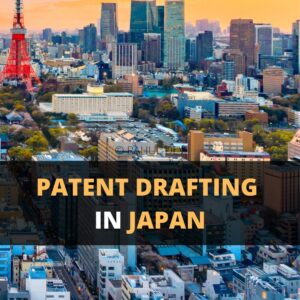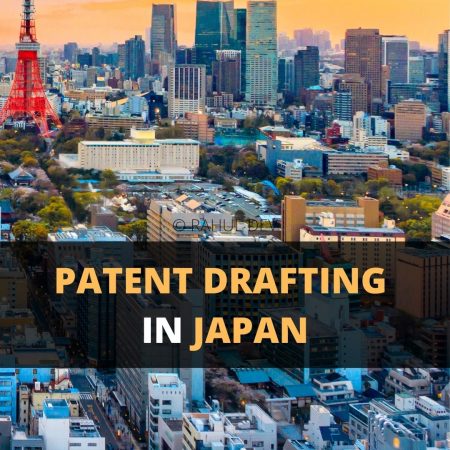Patents in Japan
Explore the Process to Write Strong Patent Applications for Japan

Understand Practical Aspects
Understand how to draft strong patent claims

Explore the Process to Write Strong Patent Applications for Japan

Understand how to draft strong patent claims

Protect your innovations across multiple countries and create strong patent portfolio to boost business valuation
Local and global brand protection through international trademark registrations
Extensive research and business writing for technical whitepapers and B2B content products
Here I share expert insights covering patent drafting in Japan through a patent writing guide for Japan that is derived from my learnings as an international patent attorney for last 18 years. The specific process for international patent application drafting in Japan is mostly done through the Patent Cooperation Treaty (PCT) phases, wherein the process starts with either the PCT international phase application in Japan and subsequently proceeds towards PCT national phase in Japan. These aspects of patent drafting in Japan need thorough alignment and compliance with the patent practice standards of the Japan Patent Office (JPO). Specifically Known for its stringent examination process, the JPO requires applications that are not just thorough but also tactically sound, integrating both technical and legal sections of the patent application to highlight the novelty and inventive step of the invention.
This article covers following topics:
Process of Drafting a Patent in Japan
Japan’s Patent Drafting Landscape
Japan’s Methodology for Creating Patent Drafts

An interesting example in this regard is an international patent application with the title “AI device, laser radar device, and wind farm control system.” This patent discloses an artificial intelligence (AI) device that includes a learning device and a control device. The learning device uses machine learning to analyze wind vectors and predict the power generated by a wind turbine. It compares the predicted value with the actual measured value and, if the difference exceeds a certain threshold, selects a laser radar device to measure the wind vector and obtain a measurement parameter. The control device then transmits this parameter to the laser radar device.
A thorough review of the patent claims of this Japanese patent application filed by MITSUBISHI ELECTRIC CORPORATION reveals that the main claim covers a new system that combines advanced machine learning and laser radar (LIDAR) technology to get the most out of wind energy output. The parts and functions of this invention include various elements, like a Learning Device that looks at wind vectors using machine learning algorithms.
As may be seen, while writing patent applications for Japan, drafting good patent claims, particularly for complicated technology, requires a deliberate and precise approach. Begin with broad claims to cover the fundamental parts, then use dependent claims for more specificity and detail. Avoid ambiguity by using clear, precise language and regularly defining technical words. Clearly describe each component of the invention and how they interact to communicate the invention’s full value. To enhance patent strength and enforceability, it’s essential to draft claims that address future technological developments while illustrating the novelty and inventiveness of the invention. For the same reasons, patent attorneys clearly define what sets your invention apart from prior art, emphasizing its innovation and non-obvious nature. By reviewing precedents and guidelines from relevant patent offices, the patent writers ensure that the patent claims align with current standards as defined by the Japan Patent Office. In the detailed description section of the patent application, it always helps to include examples to demonstrate the invention’s scope and working for the understanding of a reader who is skilled in the art of the technology field of the invention. Therefore, multiple review rounds with experts in both technology and patent law are crucial to finalize the contents of the patent application. At the end of the review, the goal is to confirm that your patent claims meet the legal requirements of the Japan patent office. In terms of patent writing style in Japan, drafting patents demands explicit language and detailed technical descriptions that are in line with the best practices followed by other patent offices like USPTO, EPO, UKIPO and even WIPO for PCT patent applications. The Japanese Patent Office (JPO) requires clarity in both technical descriptions and claims.
In Japan, the precision of aligning patent applications with the standards of the Japanese Patent Office (JPO) is critical for securing patents effectively. For instance, Sharp Corporation, which is distinguished for its electronic products, consistently aligns its applications with JPO requirements. Sharp is able to effectively obtain patents for its innovations, such as its LCD technology, as a result of its strict adherence to the patent laws of Japan. Consequently, a comprehensive comprehension of the JPO’s procedural requirements for patent practice in Japan is necessary for the crafting of a patent. Sharp is a prime example of how adhering to these standards can considerably improve a company’s capacity to secure patents and establish a strong market position. In order to safeguard their technological innovations, it is imperative for businesses to integrate complete adherence to the local patent guidelines into their strategy. This compliance guarantees that patent applications are not only well-written but also robustly defendable, thereby protecting the company’s intellectual assets. This strategy is essential for the purpose of leveraging global patent drafting in Japan and improving the worldwide patent drafting capabilities.
A proactive strategy is crucial in the constantly changing landscape of patent drafting in Japan, particularly with the emergence of technologies like as blockchain and AI. Sony’s approach to obtaining patents for its AI-powered gaming technologies demonstrates a commendable example of flexibility. Sony maintains its market position by staying up-to-date with both technological advancements and regulatory changes, which allows the company to safeguard its innovations. The main point to understand is that constantly adjusting one’s patent strategy is not only advantageous, but also essential for maintaining competitiveness. In fast evolving areas such as technology, where improvements occur at an exponential rate, a company’s capacity to predict and adapt to changes can determine its level of success. It is essential to interact with experienced patent attorneys and remain updated on legal advancements. By taking a proactive strategy, you can ensure that your intellectual property rights are strong and in line with the most current industry standards and technologies. Businesses dealing in high-tech industries must regularly assess their patent strategies to ensure success. This involves evaluating emerging technology and any legal modifications that may affect the validity and enforcement of patents. By doing this, organizations may preserve a competitive advantage in the global market and guarantee that their ideas are sufficiently safeguarded.
To ensure a successful patent strategy in Japan, it is crucial to consistently adapt to the newest technical advancements and adhere to the requirements set by the Japan Patent Office (JPO). Businesses must prioritize the scheduling of quarterly reviews of their patent strategy with their legal team and local specialists. This strategic methodology aids in the identification of prospective gaps and chances for novel patents, guaranteeing strong safeguarding that is in line with corporate expansion plans. Regular updates and strategic assessments are essential for Japan’s patent drafting approach to ensure that patent protections remain pertinent in the swiftly changing technological landscape.
An essential lesson for organizations striving to remain competitive is the significance of maintaining constant vigilance in their patent strategy. Regular evaluations enable organizations to adjust to emerging technical developments and regulatory modifications, guaranteeing that their ideas remain safeguarded under the most up-to-date legal criteria. This approach serves as more than simply a means of protection, as it provides a strategic imperative that facilitates continuous business expansion and innovation.
By implementing a regular quarterly review, organizations may effectively and promptly adapt to changes in technology and JPO rules. This helps to minimize the risk of patent infringement and improve the commercial viability of their patents. This strategy is backed by industry research that emphasizes the substantial competitive edge achieved by actively managing intellectual property. Strategic vigilance in global patent drafting in Japan and worldwide patent drafting is crucial for capitalizing on technical breakthroughs and sustaining a competitive advantage in the market. Businesses should implement this systematic evaluation method to guarantee that their patent strategies consistently conform to contemporary standards and technology, protecting their innovations and advancing their strategic business goals.

As a business coach and thought leader, I cannot emphasize enough the importance of innovation, new software patents, mobile apps, and patents for tech companies, startups, and entrepreneurs. The world is rapidly evolving, and staying ahead of the curve is vital for success. Embracing technological advancements such as blockchain and AI can unlock unprecedented opportunities, streamline operations, and propel businesses into the future with competitive valuation via intangible assets.
Click Here for AI Startup Valuation Guide.
For instance, blockchain technology can revolutionize supply chain management and secure data sharing wherein innovative business models are explained to the audience via technical whitepapers, while AI can automate and optimize decision-making processes. Mobile apps are no longer just a luxury; they have become essential tools for engaging customers and offering personalized experiences. Furthermore, securing digital innovation patents is crucial for protecting intellectual property, fostering innovation, and maintaining a competitive edge. By investing in these areas, businesses can position themselves as industry pioneers and pave the way for a prosperous future after thoroughly conducting the due diligence and reviewing the legal opinion letters, which in case of digital assets can assist in determining the tokens as utility assets or coins as utility tokens before listing the assets at an exchange.
Our team of advanced patent attorneys assists clients with patent searches, drafting patent applications, and patent (intellectual property) agreements, including licensing and non-disclosure agreements. Advocate Rahul Dev is a Patent Attorney & International Business Lawyer practicing Technology, Intellectual Property & Corporate Laws. He is reachable at rd (at) patentbusinesslawyer (dot) com & @rdpatentlawyer on Twitter.
Quoted in and contributed to 50+ national & international publications (Bloomberg, FirstPost, SwissInfo, Outlook Money, Yahoo News, Times of India, Economic Times, Business Standard, Quartz, Global Legal Post, International Bar Association, LawAsia, BioSpectrum Asia, Digital News Asia, e27, Leaders Speak, Entrepreneur India, VCCircle, AutoTech).
Regularly invited to speak at international & national platforms (conferences, TV channels, seminars, corporate trainings, government workshops) on technology, patents, business strategy, legal developments, leadership & management.
Working closely with patent attorneys along with international law firms with significant experience with lawyers in Asia Pacific providing services to clients in US and Europe. Flagship services include international patent and trademark filings, patent services in India and global patent consulting services.
Global Blockchain Lawyers (www.GlobalBlockchainLawyers.com) is a digital platform to discuss legal issues, latest technology and legal developments, and applicable laws in the dynamic field of Digital Currency, Blockchain, Bitcoin, Cryptocurrency and raising capital through the sale of tokens or coins (ICO or Initial Coin Offerings).
Blockchain ecosystem in India is evolving at a rapid pace and a proactive legal approach is required by blockchain lawyers in India to understand the complex nature of applicable laws and regulations.